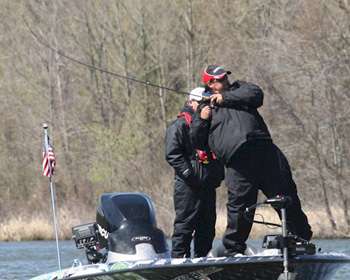
Of all the techniques widely used by professional bass anglers, a few continue to fly under the radar. "Dead sticking" soft plastics is one of them, but that's most definitely not because it doesn't put fish in the boat.
In fact, as Elite Series pro Chris Lane points out, there are times during the year when the technique is downright lethal. "Dead sticking becomes much better, the closer you get to the spawn," he says. "The bass aren't chasing anything this time of the year and they become ultra-defensive."
Dead sticking is a presentation most often involving a Texas rigged, weightless soft plastic stickbait that is allowed to rest motionless on the bottom. Lane points out that it's the slow-moving nature of the technique that makes it a perfect choice to use early in the year.
Dead sticking is part of Lane's bed-fishing arsenal as well. "You can cover an area with your trolling motor looking for beds and see fish cruising away," he says. "Chances are there's a bed nearby, so I like to fire the bait out and just dead stick it. If you wait long enough they'll come back and grab it."
Though the technique is red-hot during the spawn, Lane admits that it quickly cools as the water continues to warm. "I won't generally fish it any other time of the year," Lane says. "It's a really neat tactic, but it takes a lot of patience so you really want to use it during the time of the year when you're most likely to get bit." In southern states like Florida and Texas, the technique begins to become effective as early as January.
Lane points out that the best way to effectively dead stick a soft plastic is to simply let it freefall and sit motionless on the bottom. That's when the waiting game begins. "I'll usually let it sit there for a minute to a minute-and-a-half," he says. "That doesn't seem like a long time until you're out there trying to do it — then it seems like forever." While he is waiting for a strike, Lane keeps a small amount of tension on his line and watches it closely for any indication of a strike. "Most of the time you'll just see your line start moving off," he says.
Lane explains that the strike will usually occur as the bait is lying motionless. "Sometimes, though, they'll nail it on the initial move," he says. "It's almost like they're just sitting there waiting for it to do something. If they haven't hit it by then, I'll reel in and look for the next target."
As for tackle, Lane explains that the rod choice isn't as important as line, given the technique's "finesse-like" characteristics. "I like to use fluorocarbon no heavier than 12-pound test," he says. With fluorocarbon's unique underwater properties, it is less visible to the bass than monofilament or braided line.
"You have to consider dead sticking as another version of finesse fishing," says Lane.




